
Whether you live in Colorado, vacation there, or just briefly visit on your way through (but really, you should stay a while), you already know about its mountains, mining history, skiing—and of course, its really good craft beer. But Colorado is also renowned for fossil discoveries, (especially dinosaurs!).
The state’s fossil history stretches back nearly half a billion years, and Colorado has been the site of some very important discoveries in the field of paleontology.
What Are Fossils?
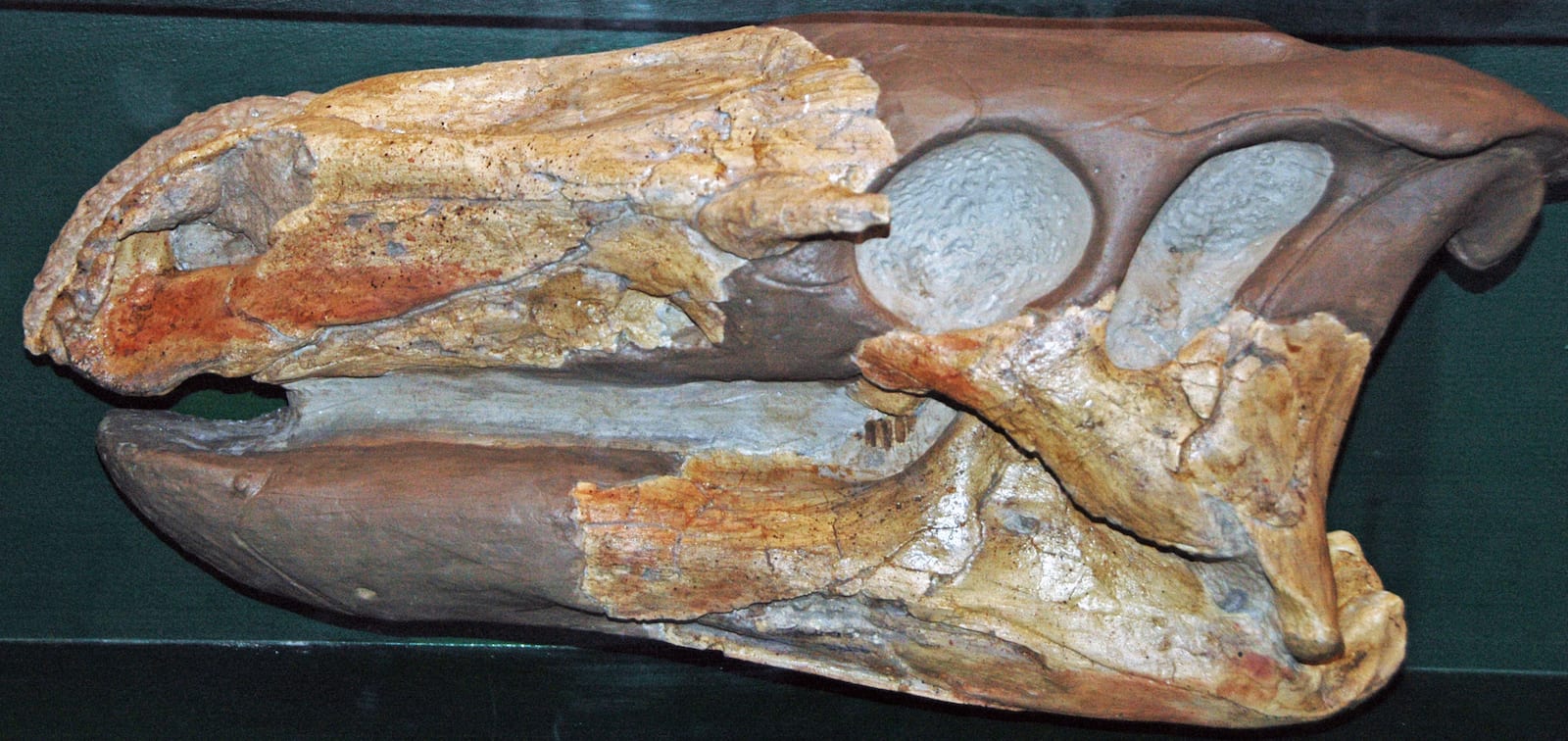 Ornithopod dinosaur skull from Lower Cretaceous; Garden of the Gods Visitor Center, Colorado Springs. Photo: James St. John
Ornithopod dinosaur skull from Lower Cretaceous; Garden of the Gods Visitor Center, Colorado Springs. Photo: James St. John
A fossil is any preserved remains of ancient life—plants, animals, even bacteria and fungi. Fossils can be bones, wood, shells, leaves, tracks, and even feces. Fossils can tell us how organisms moved, ate, reproduced, lived and died, and often how they were related to one another.
They can also help us understand what Colorado has looked like through millions of years. Fossils are really the ultimate time machine, and it’s a fun way to head into the past and learn about the state’s prehistory.
The Paleozoic
541 to 252 million years ago
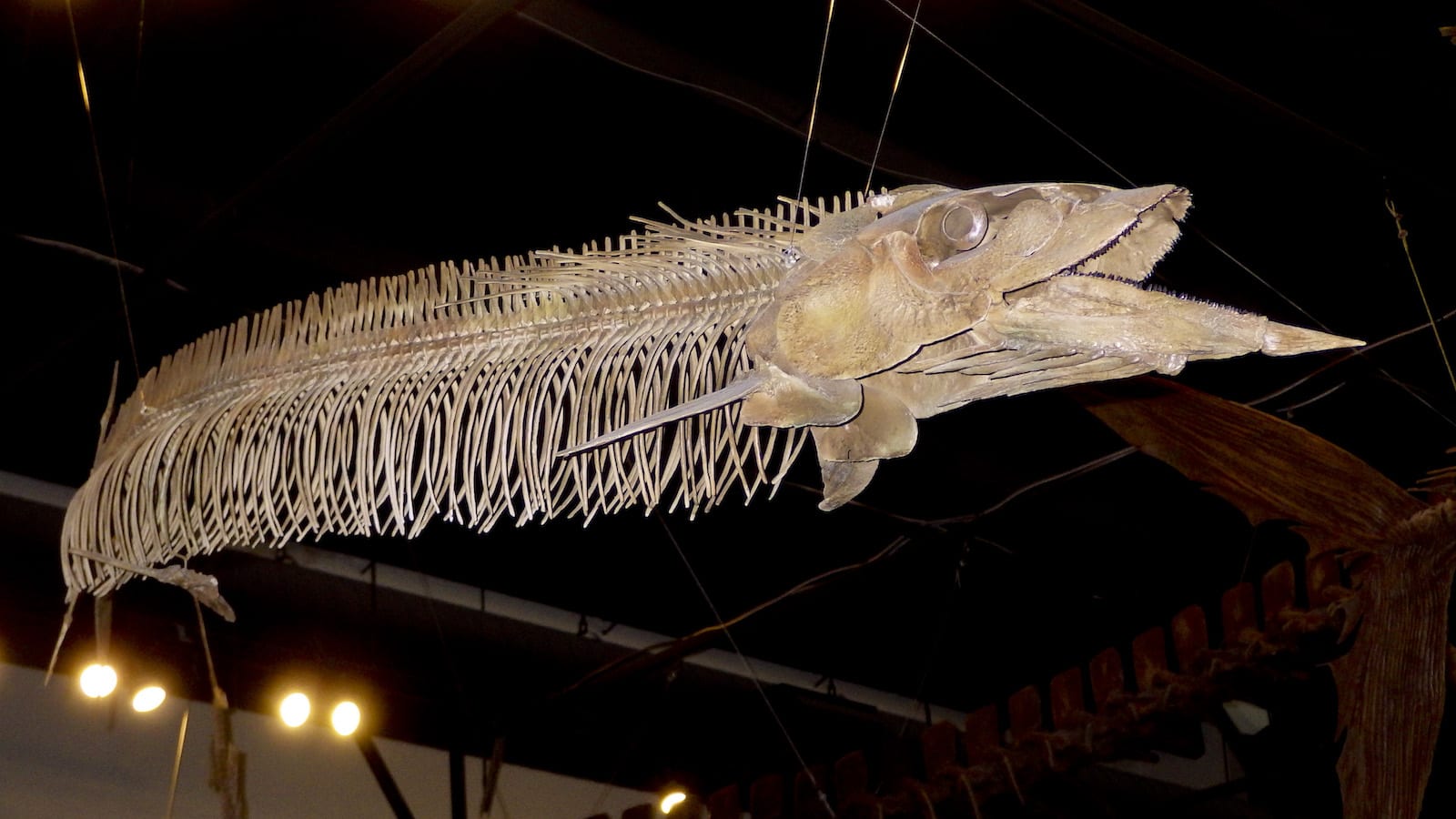 Prehistoric fish skeleton at Dinosaur Resource Center, Woodland Park. Photo: Dave Thomas
Prehistoric fish skeleton at Dinosaur Resource Center, Woodland Park. Photo: Dave Thomas
Even though some rocks in Colorado are literally billions of years old, these aren’t the types of rocks that contain fossils; the first evidence of ancient life in the state is only about 500 million years ago.
At this time of the Age of Fishes, the land that would become Colorado lay near the Equator. It was covered with a shallow ocean that existed off and on in various parts of the state for the next 200 million years.
In the sediments deposited throughout this time, there are burrows and trails of worms and other marine critters, shellfish known as brachiopods, sponges, clams, snails, and trilobites. Near Cañon City, paleontologists have found evidence of primitive fish in rocks that are about 450 million years ago. What’s cool about these early fish is that they had bony armor covering their bodies and no jaws. Instead, they fed by sucking water and food through mouth slits in their armor. After about 400 million years ago, we also find sharks in Colorado’s oceans.
Ancestral Rockies
Colorado’s fossil history becomes much more visible starting around 300 million years ago. Seas had come and gone across the land a few times and, at this point, the western half of Colorado looked really different than the east. The Ancestral Rockies were beginning to form (the range was called the Ancestral Rockies because it existed partly where the Rockies are today, not because it was the beginning of the current mountain range) and ultimately, these mountains extended from Colorado southeast to Arkansas.
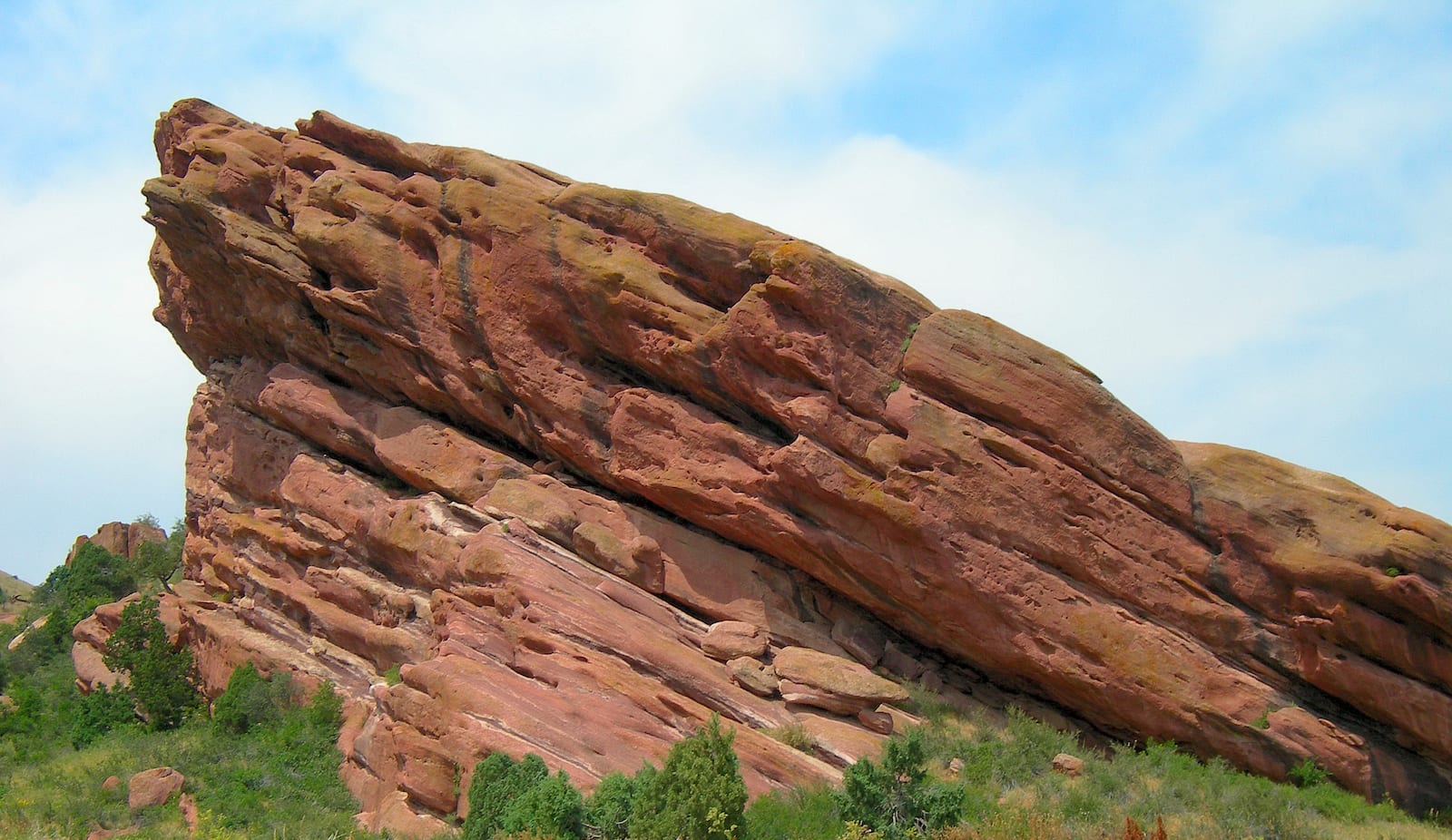 Rock formation at Red Rocks Park is part of the Ancestral Rocky Mountains created 300 million years ago. Photo: klaxtonphoto
Rock formation at Red Rocks Park is part of the Ancestral Rocky Mountains created 300 million years ago. Photo: klaxtonphoto
West of these mountains in the southwestern part of the state, the Paradox Basin was flooded with a warm, shallow sea where brachiopods, sponges, trilobites, and creatures known as crinoids (which are related to sand dollars and sea stars) lived. There are even fossilized coral reefs in the Hermosa Formation of southwestern Colorado and southeastern Utah.
Fountain Formation
To the east, rivers carried sediment off the Ancestral Rockies and deposited the Fountain Formation, which you can see today along the Front Range (at Red Rocks Amphitheatre, among other places) and also in the Vail and Minturn areas. Along these rivers grew forests of primitive conifers, massive “scale” trees that looked like something out of a Dr. Seuss book, and enormous horsetails nearly a foot in diameter and 20 or more feet high.
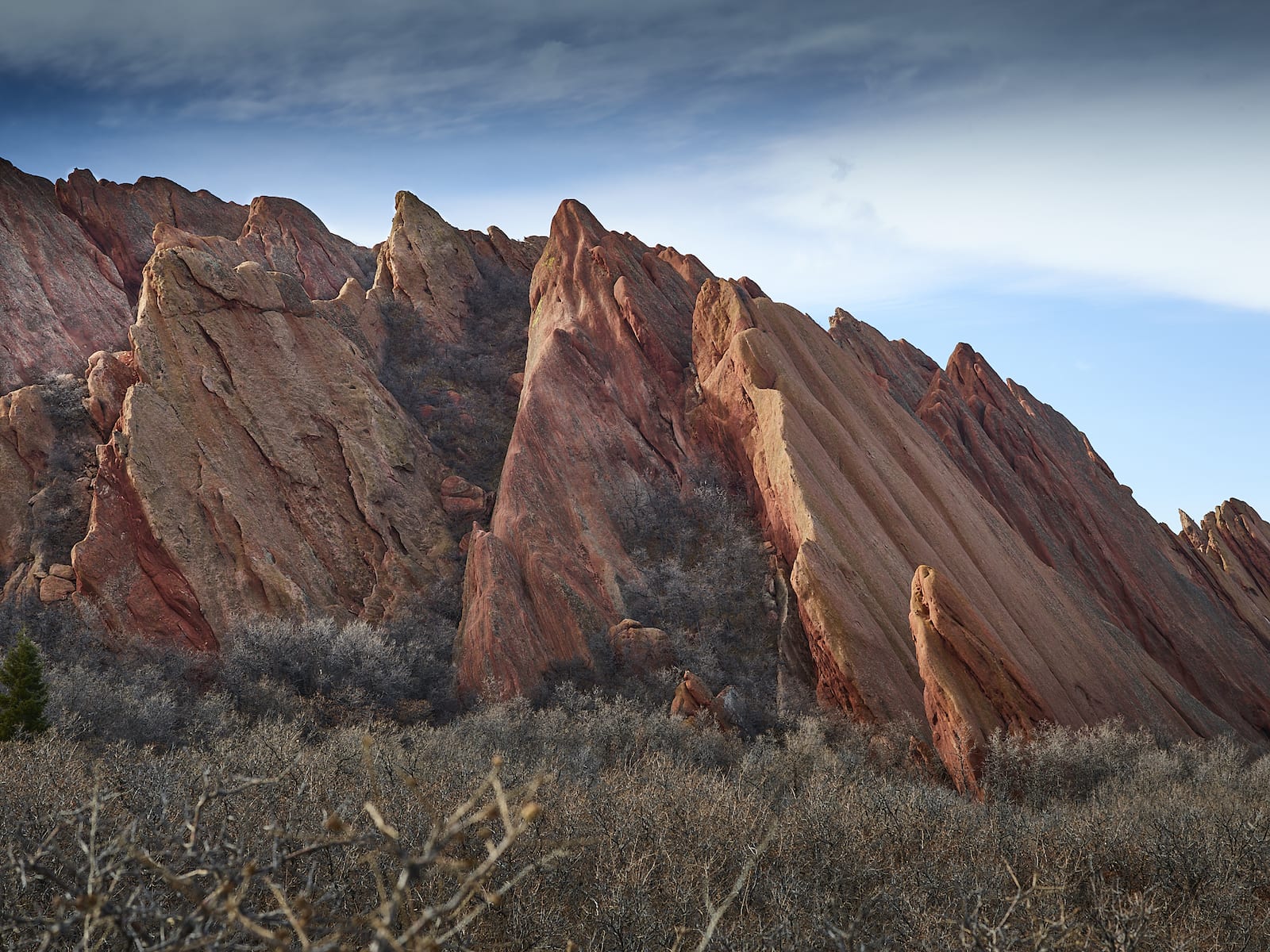 Red sandstones typical of Fountain Formation at Roxborough State Park. Photo: Larry Goodwin
Red sandstones typical of Fountain Formation at Roxborough State Park. Photo: Larry Goodwin
These forests provided habitat for massive dragonflies, cockroaches, and huge millipedes, as well as fish, amphibians, and early reptiles. Although the Fountain Formation in Colorado doesn’t contain a lot of animal fossils, we know they were there because they are found just to the east in Kansas, which was just a bit further downstream on these same rivers.
By about 280 million years ago, most of the continents were gathered together into what would become the giant supercontinent known as Pangea (meaning “all-Earth”). The climate was dry and windy; a lot of the West was covered with “seas” of sand dunes and Colorado was no exception.
Lyons Formation
Along the Front Range, the Lyons Sandstone (which you can see at Garden of the Gods, Roxborough State Park and, of course, near Lyons) was deposited in these dune fields.
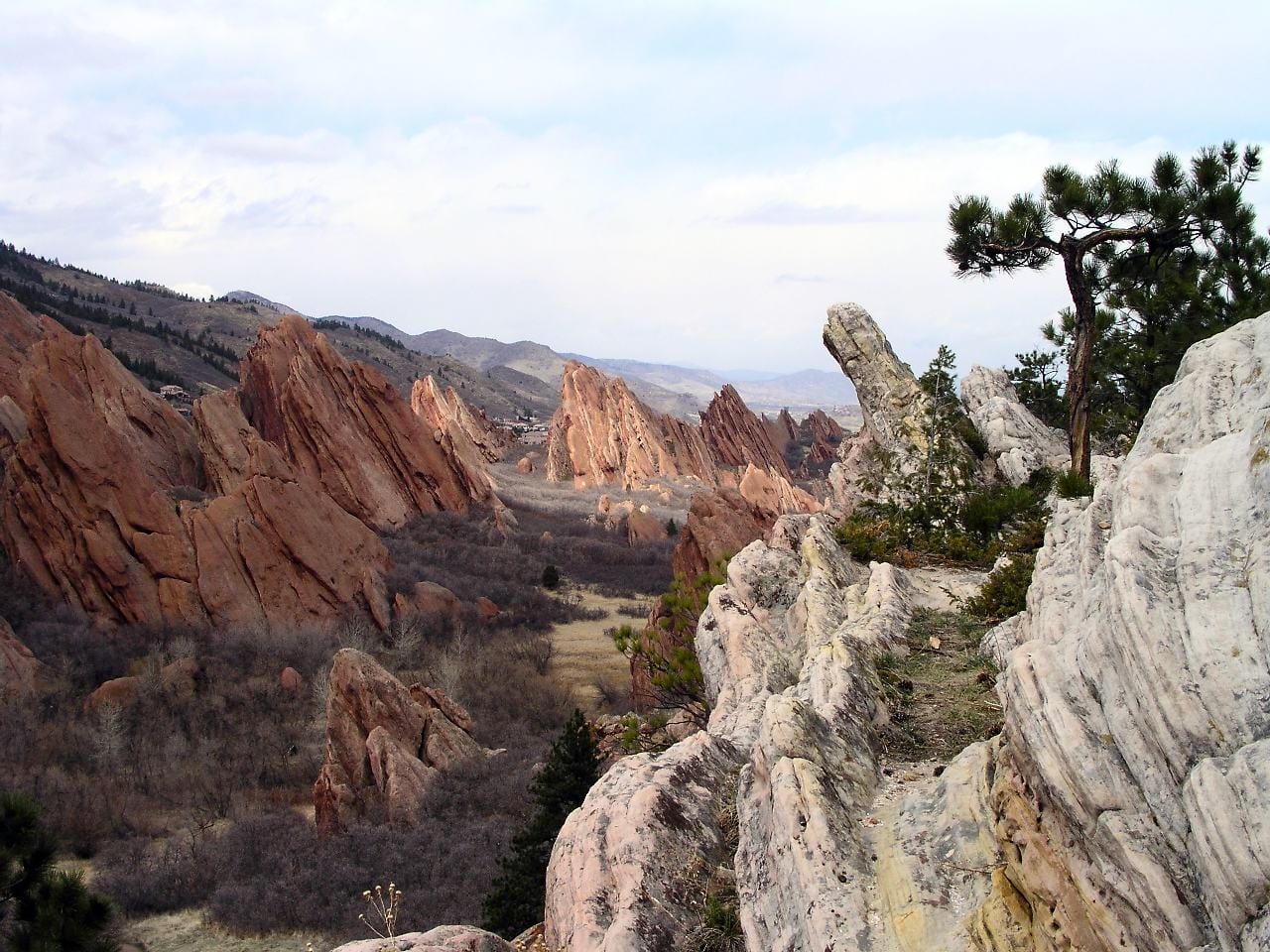 Buff and pink colored rocks (right) typical of Lyons Formation at Roxborough State Park near Littleton. Photo: Montano336
Buff and pink colored rocks (right) typical of Lyons Formation at Roxborough State Park near Littleton. Photo: Montano336
Occasionally the flat sandstone slabs that people use in patios and walkways will have the fossilized tracks of reptiles, scorpions, spiders, or millipedes that walked these dunes.
About 250 million years ago more than 90 percent of marine creatures and a huge percentage of land plants and animals died out in the biggest mass extinction in Earth’s history. This created a lot of ecological openings for new plants and animals. In Colorado—and around the world—it ushered in the Age of Dinosaurs (Mesozoic Era).
Mesozoic: the Age of Dinosaurs (or Reptiles)
252 to 66 million years ago
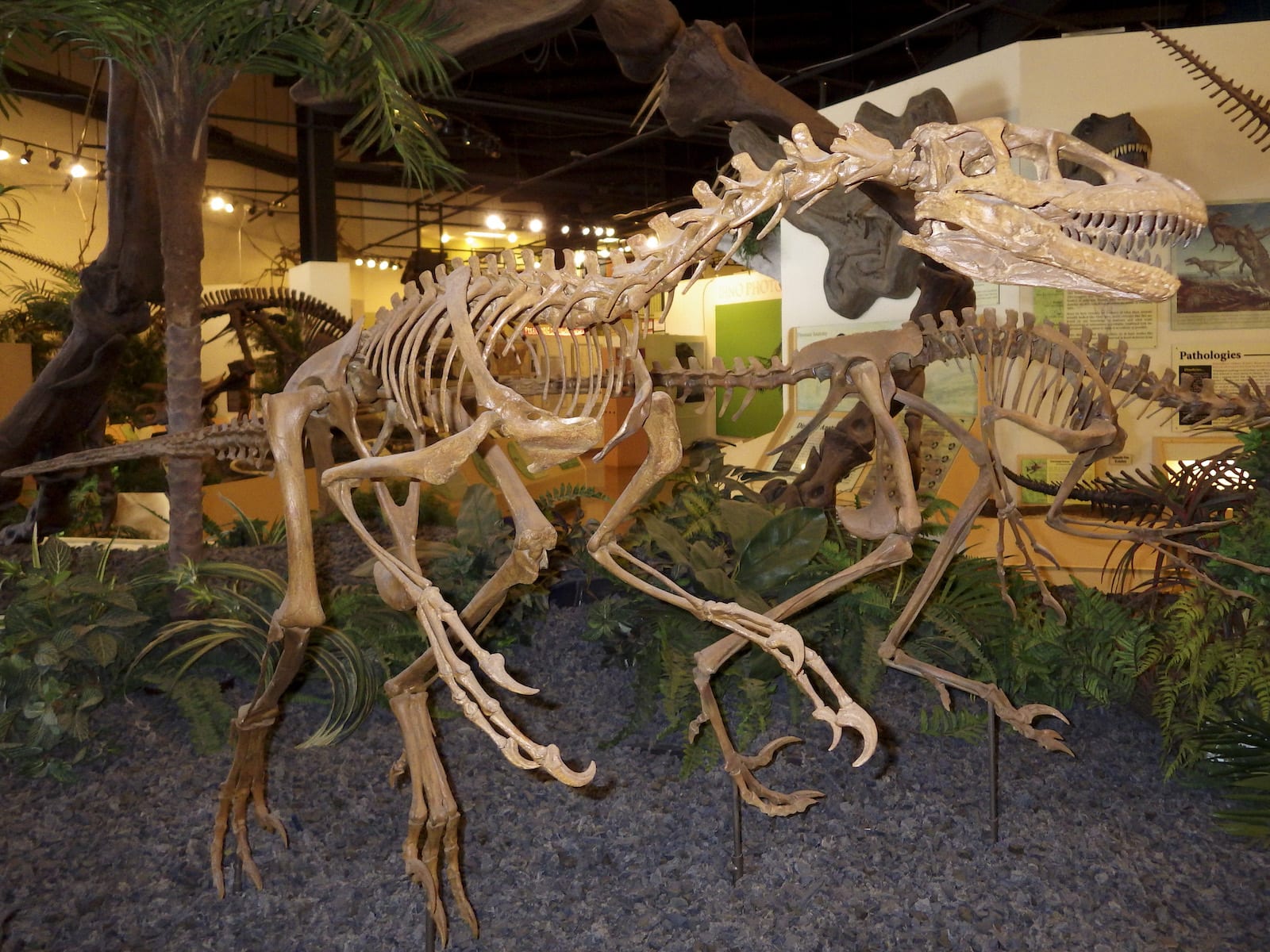 Raptor skeletons at Dinosaur Resource Center, Woodland Park. Photo: Dave Thomas
Raptor skeletons at Dinosaur Resource Center, Woodland Park. Photo: Dave Thomas
By about 200 million years ago, the rivers flowing from the eroding Ancestral Rockies had buried a lot of Western Colorado in a thick layer of sediment known as the Chinle Formation (this rock layer is found throughout the West and is probably most famous in Arizona’s Painted Desert).
In the Eagle Basin near Glenwood Springs paleontologists have found Colorado’s earliest dinosaurs—small, bipedal carnivores, about six feet long with a whip-like slender tail. They were lightly built and moved fast in search of prey such as lizards and early mammals. At this point in time they were outnumbered by larger and fiercer animals; it would be a few million years before the dinosaurs took center stage in Colorado and the world.
But take center stage they did! By about 150 million years ago, the land that would become Colorado was chock full of dinosaurs of all sizes, shapes, and lifestyles. For the past century and a half, scientists have been finding their fossils and many others in one of the most remarkable rock layers in the western United States: the Morrison Formation.
Morrison Formation
The Morrison Formation was first discovered and described in 1877 at Dinosaur Ridge near Morrison. Also described were several big dinosaurs, including Stegosaurus (which became Colorado’s state dinosaur), Apatosaurus (originally called Brontosaurus), Diplodocus, and Allosaurus, giving Colorado the distinction of being the first state west of the Mississippi where nearly complete skeletons of large dinosaurs were found. (Even today, Colorado is routinely in the news with new discoveries. Several dinosaur finds have been made by CDOT crews, and dinosaur fossils were even found during the construction of Coors Field!)
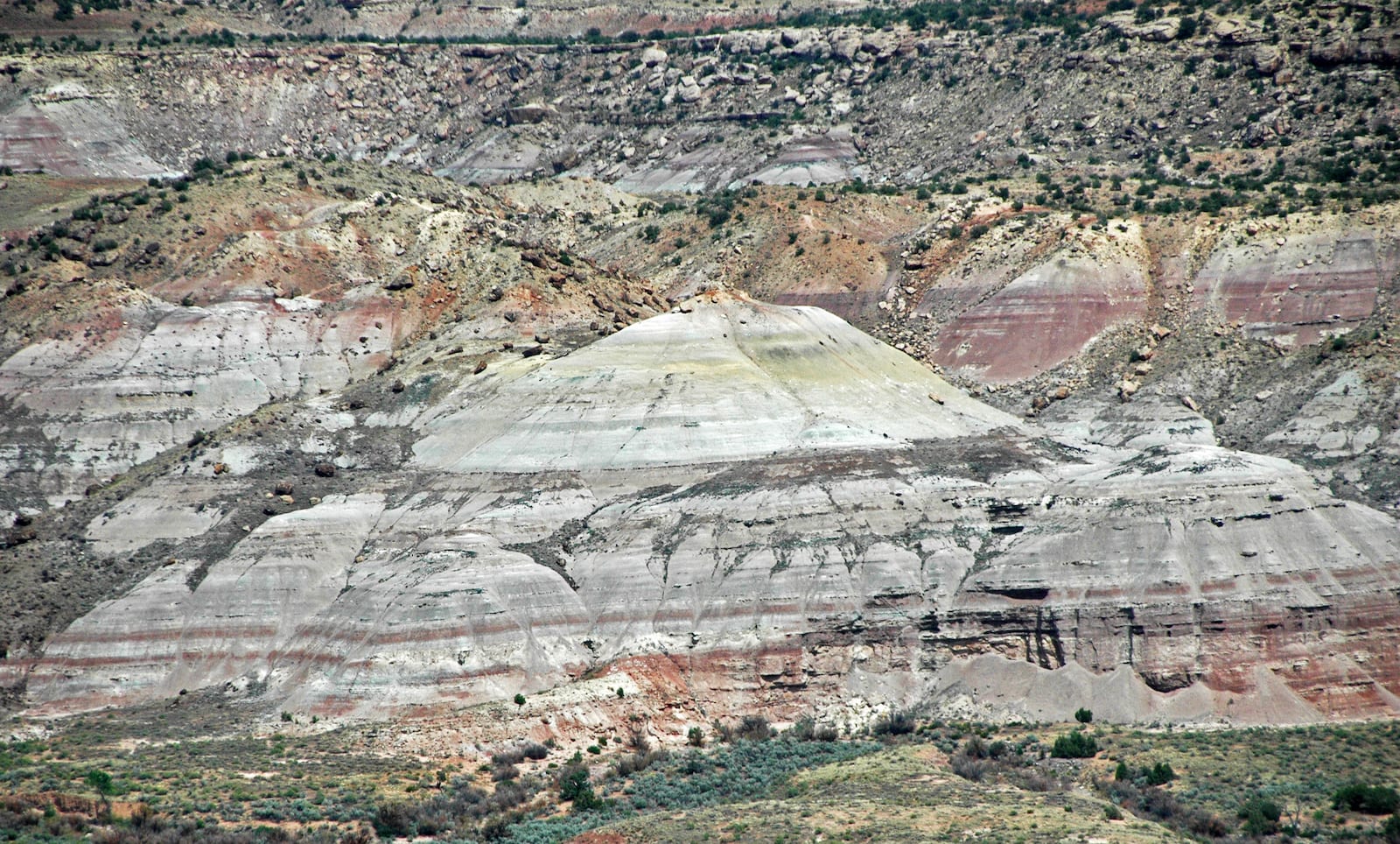 The distinctive banding of the Morrison Formation, Colorado National Monument. Photo: James St. John
The distinctive banding of the Morrison Formation, Colorado National Monument. Photo: James St. John
The Morrison Formation is found all over the West, and in Colorado one of the most famous places to see it other than Dinosaur Ridge is at Dinosaur National Monument. Since 1909, paleontologists there have been finding fossils from dozens of species of plants and animals that lived along rivers that meandered across the region 150 million years ago. Hundreds of tons of bone were excavated from the monument’s main fossil quarry alone.
Plant and Dinosaur Fossils
More than 200 species of plants have been found in the Morrison Formation, including conifers, horsetails up to 90 feet tall, ferns, ginkgoes, and giant tree ferns—suggesting warm, wet temperate forests, with drier plains on the uplands near the rivers.
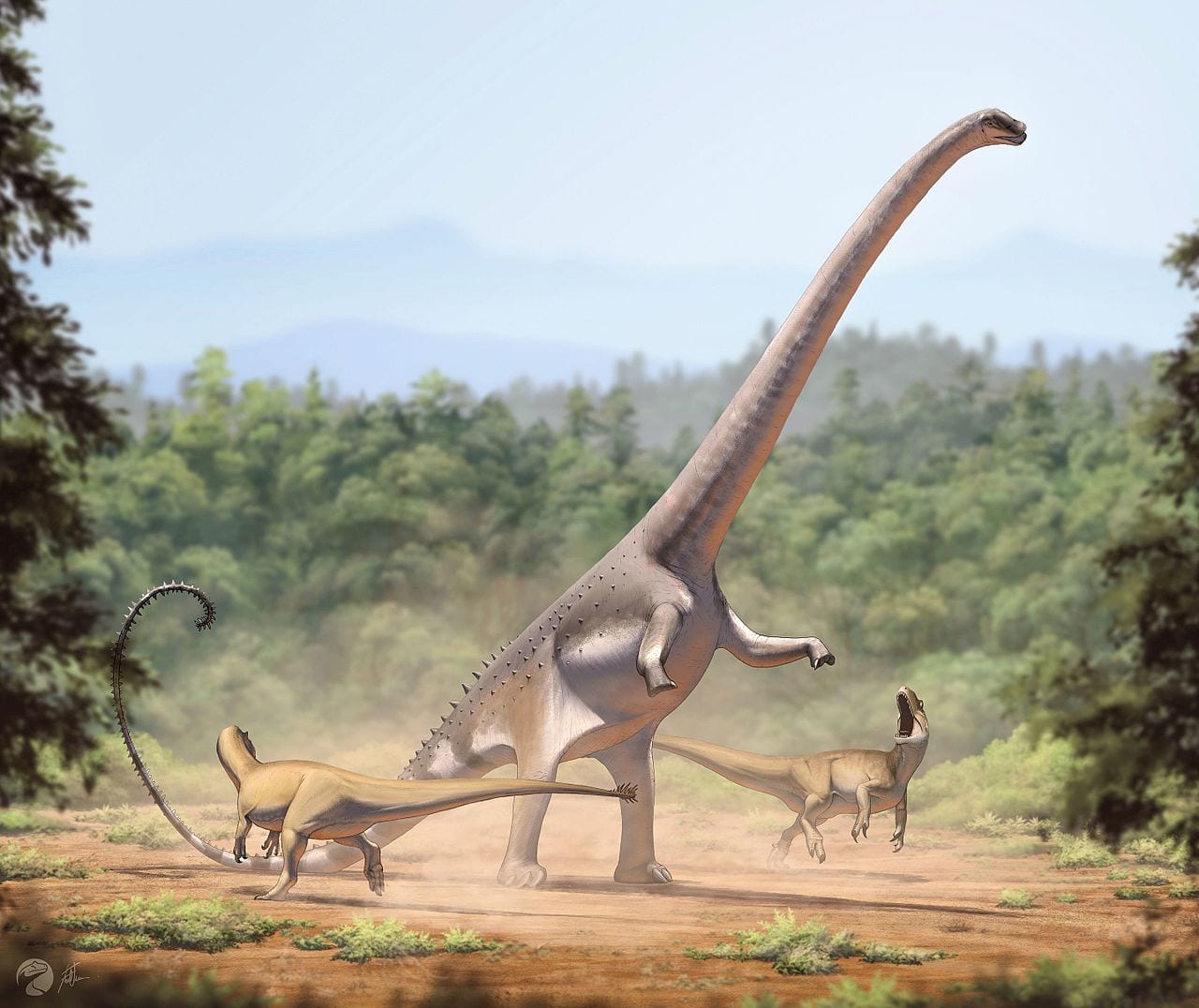 Barosaurus and Allosaurus. Photo: Fred Wierum .
Barosaurus and Allosaurus. Photo: Fred Wierum .
Immense dinosaurs such as Diplodocus, Camarosaurus and Barosaurus (with the longest of all long necks) lived on the lowlands. Instead of browsing the treetops as their long necks suggest, they probably munched watery streamside vegetation and may have even pushed over trees like modern elephants when they wanted leaves. These giants attained unbelievable proportions: seventy-five feet long, forty feet high and thirty tons or more in weight.
At the Dry Mesa Dinosaur Quarry near Delta, giants have been found that rival even the blue whale in size: Seismosaurus, Ultrasaurus, and Supersaurus may have exceeded 120 feet! In the Morrison landscape, herbivores like Stegosaurus and Camptosaurus fought off predators like Allosaurus and Ceratosaurus. These unique dinosaur communities of the Morrison may have been as complex and varied as the great mammalian faunas of the modern African grasslands.
Other Animal Fossils
There were many other animals in this ecosystem as well. Freshwater clams and turtles, snails, fish, salamanders, lizards, frogs and crocodiles thrived in the slow waters of the rivers, or hung out in ponds and lakes. Early mammals scurried about underfoot; at this point they were small, insectivorous or herbivorous ground- and tree-dwelling creatures.Near Grand Junction, the Fruita Paleontological Area’s fossil quarry has yielded dinosaur eggs and hatchlings (as well as other tiny dinosaur species), in addition to lizards, snakes, frogs, fish, small flying pterosaurs, and miniscule mammals.
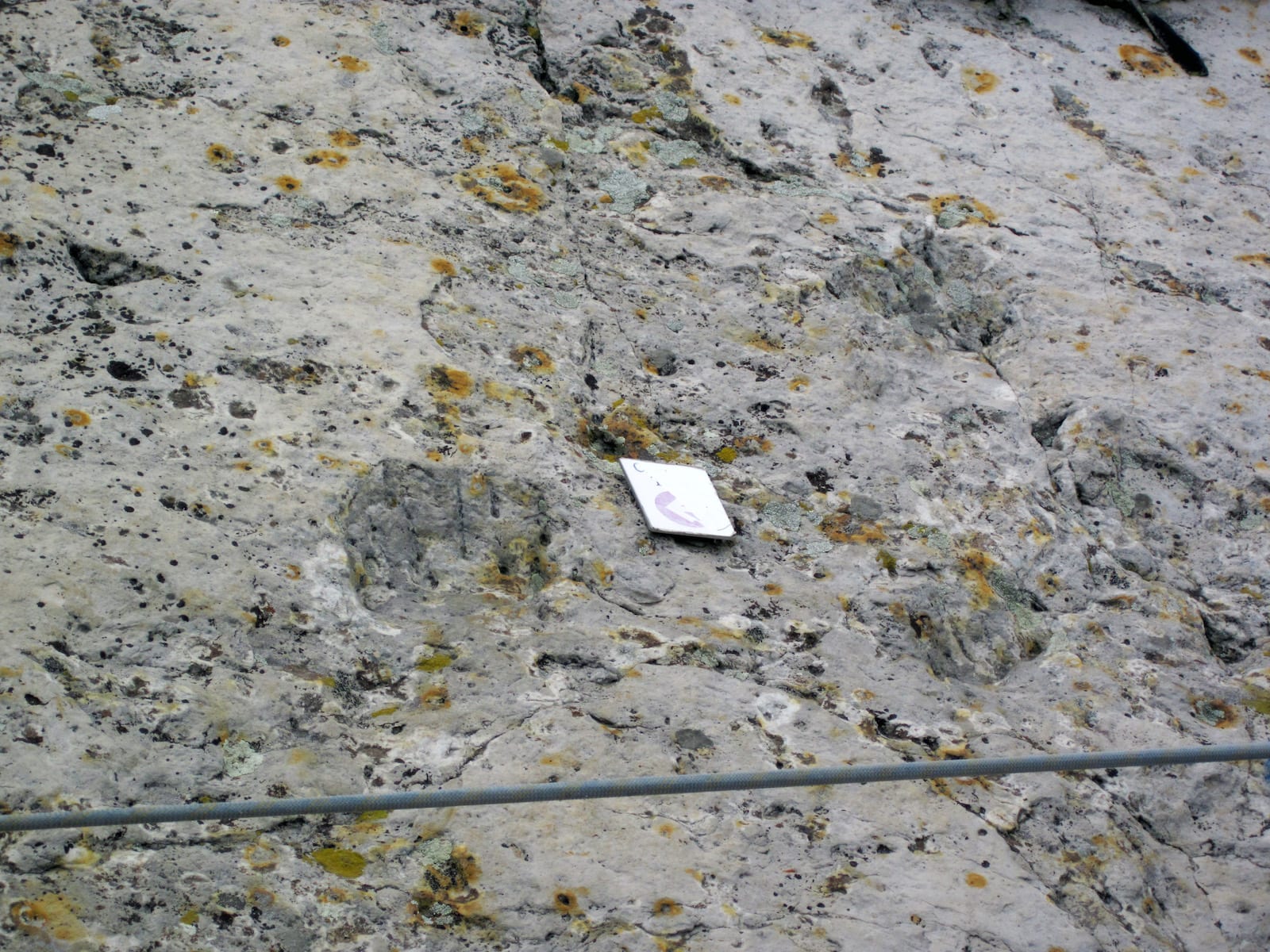 Crocodilian footprints on shoreline sandstone at Dinosaur Ridge. Photo: James St. John
Crocodilian footprints on shoreline sandstone at Dinosaur Ridge. Photo: James St. John
Fossilized Footprints
Bones are not the only dinosaur fossils in Colorado’s Morrison Formation. There are incredible fossilized footprints of some of the massive species on the west side of Dinosaur Ridge. And at Dinosaur Lake in Picketwire Canyonlands near La Junta there are more than 1,300 footprints representing at least 100 animals, both long-necks and big carnivores. The Picketwire site is one of the largest dinosaur tracksites in North America.
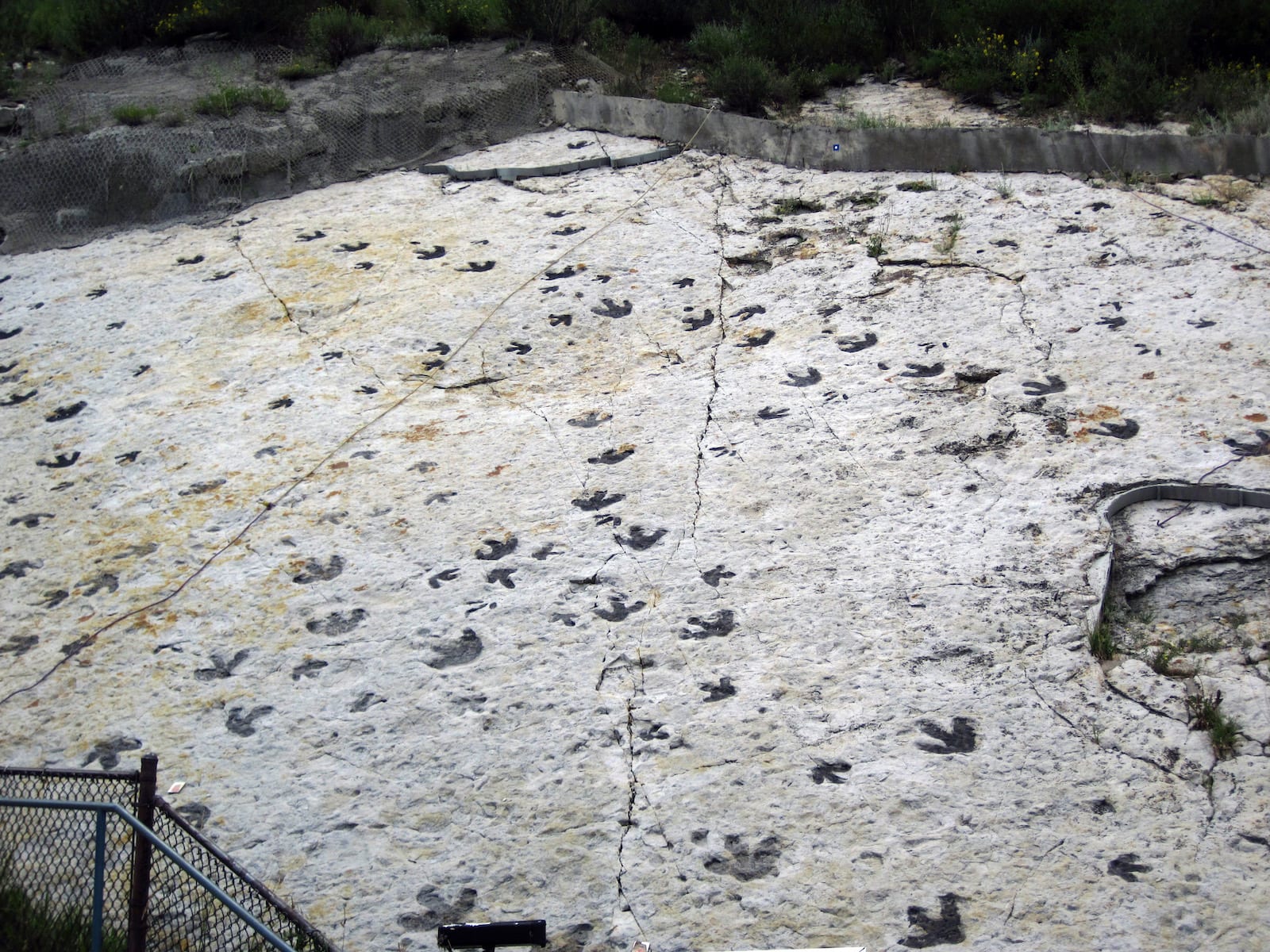 Dinosaur footprints from the Cretaceous at Dinosaur Ridge, Morrison, Colo. Photo: James St. John
Dinosaur footprints from the Cretaceous at Dinosaur Ridge, Morrison, Colo. Photo: James St. John
Directly southwest of La Junta in southern Colorado lies Trinidad Lake by Trinidad, another spot for dinosaur tracks. There’s also the K-T Boundary, a layer of dust that provides evidence that a meteorite hit the area 65 million years ago. Another incredible find in the region was a mosasaurus skeleton, now housed in the Louden-Henritze Archeology Museum at the Trinidad State Junior College.
In fact, several state parks in southeast Colorado have recorded evidence of dinosaurs.
Western Interior Seaway
By 100 million years ago, Colorado had become the coastline of the Western Interior Seaway, an ocean that stretched north to south across the central part of the continent, from the Arctic Circle to the Gulf of Mexico. The Dakota Sandstone (for which the Dakota Hogback along the Front Range is named) was deposited along this coast and preserves the remains of ferns, conifers, many broad-leafed trees and other plants, as well as thousands of dinosaur tracks on the east side of Dinosaur Ridge.
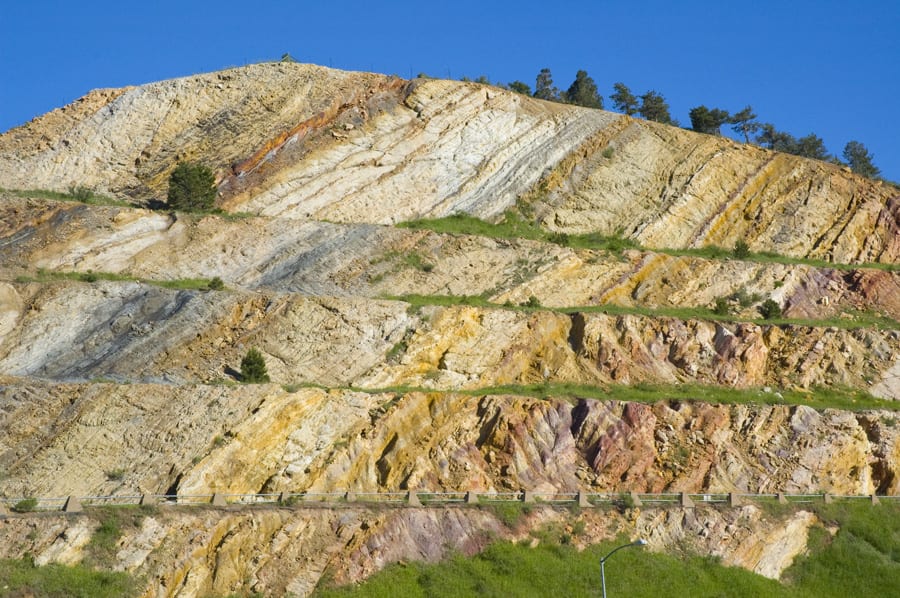 Dakota Hogback exposure by I-70 near Morrison, Colo. Photo: Mark Ryan
Dakota Hogback exposure by I-70 near Morrison, Colo. Photo: Mark Ryan
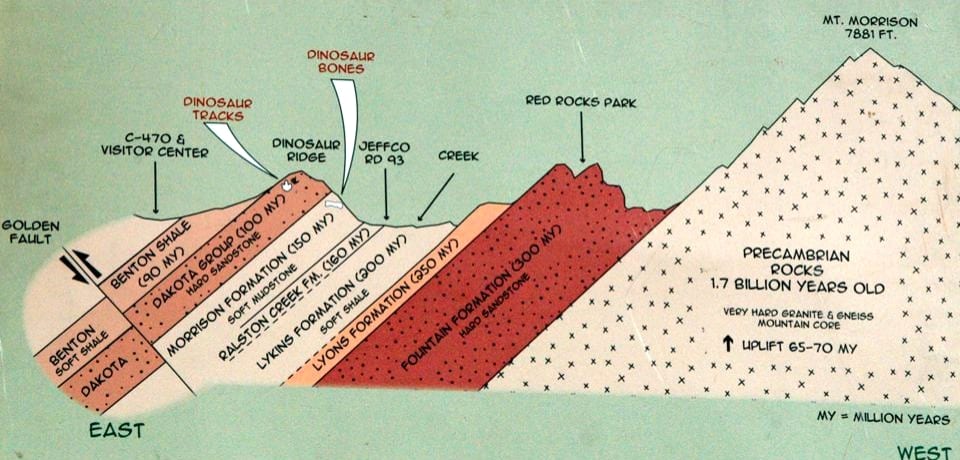 East-west geologic cross-section through the Dakota Hogback near Morrison, Colo. Photo: James St. John
East-west geologic cross-section through the Dakota Hogback near Morrison, Colo. Photo: James St. John
In addition to large carnivore tracks, there are also tracks of a plant-eater that may have been a primitive duck-billed dinosaur.
Mancos and Pierre Shale
As sea level rose, it flooded most of the state, depositing the Mancos Shale in the west and the Pierre Shale in central and eastern Colorado. These layers have produced an incredible menagerie of fossils, including coiled, squid-like ammonites, oysters, snails, rare and delicate pterosaur bones, enormous teeth of the marine reptiles known as pliosaurs and mosasaurs (think the Loch Ness monster without the long neck), sharks, and even primitive sea turtles. You can see grey hills of Pierre Shale at Garden of the Gods and the Fountain Creek Nature Center, and the Mancos Shale forms badlands near Grand Junction and Mesa Verde.
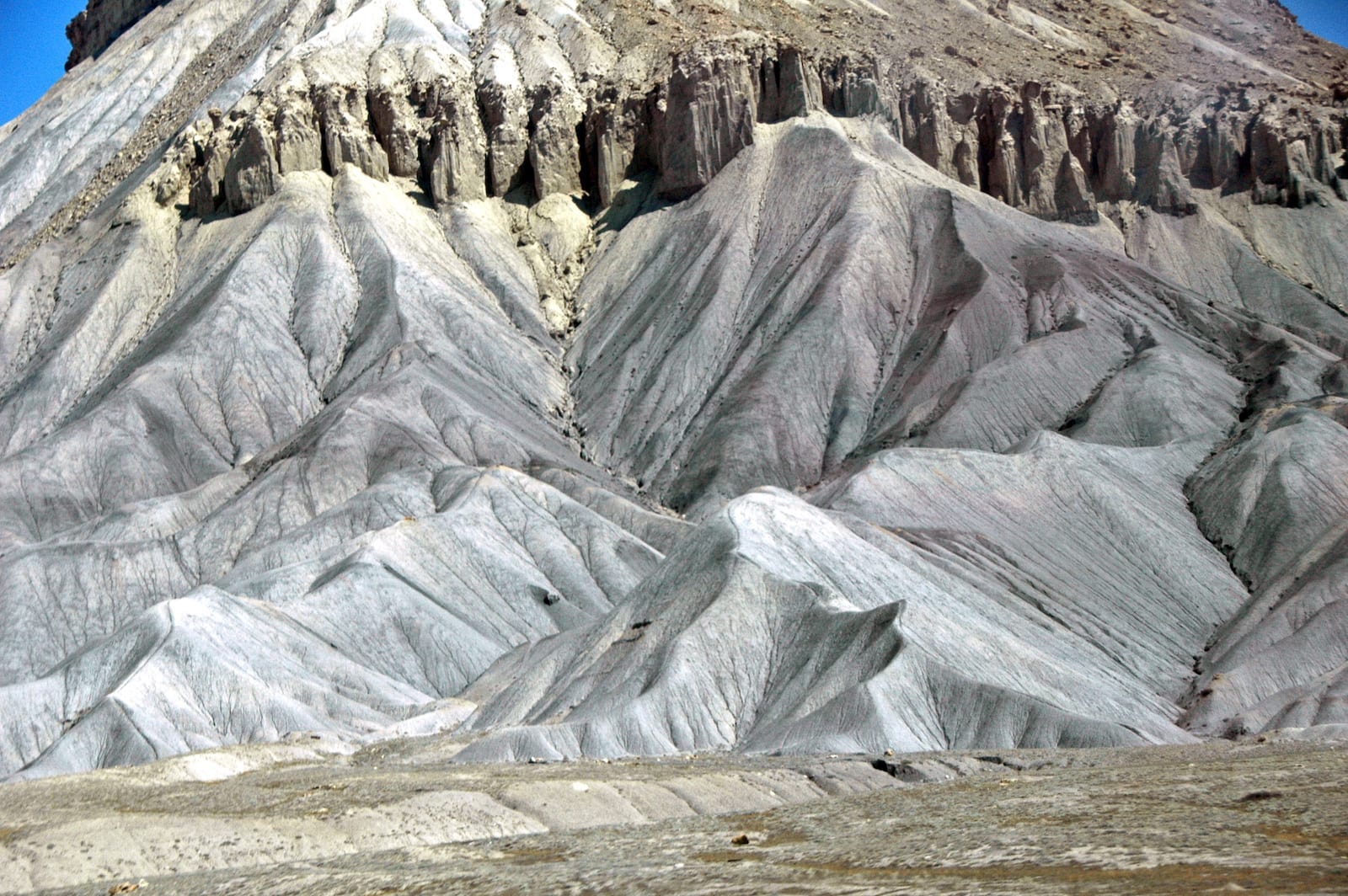 Mancos Shale badlands from Upper Cretaceous; Grand Valley, western Colorado. Photo: James St. John
Mancos Shale badlands from Upper Cretaceous; Grand Valley, western Colorado. Photo: James St. John
Over time the sea began to retreat, and Colorado again became a coastal area. The bulk of Mesa Verde in southwestern Colorado is made up of sediments that were deposited along the rivers and swamps of the coast. In these layers, paleontologists have found the remains of forests made of oaks and willows, cypress, magnolia, poplars, sycamores, and grapevines. A lot of this plant material became seams of coal in the western part of the state.
Rocky Mountains
The Rocky Mountains began to rise around 70 million years ago and by about 66 million years ago, near the end of the Age of Dinosaurs, the Front Range had formed. Rivers flowing off the Front Range deposited the Denver Formation. It doesn’t look like much, just low slopes of silt and sand along I-25 and I-70 (you can see it at Austin Bluffs Park, South Table Mountain, and Green Mountain, among other places), but this layer has produced amazing fossils.
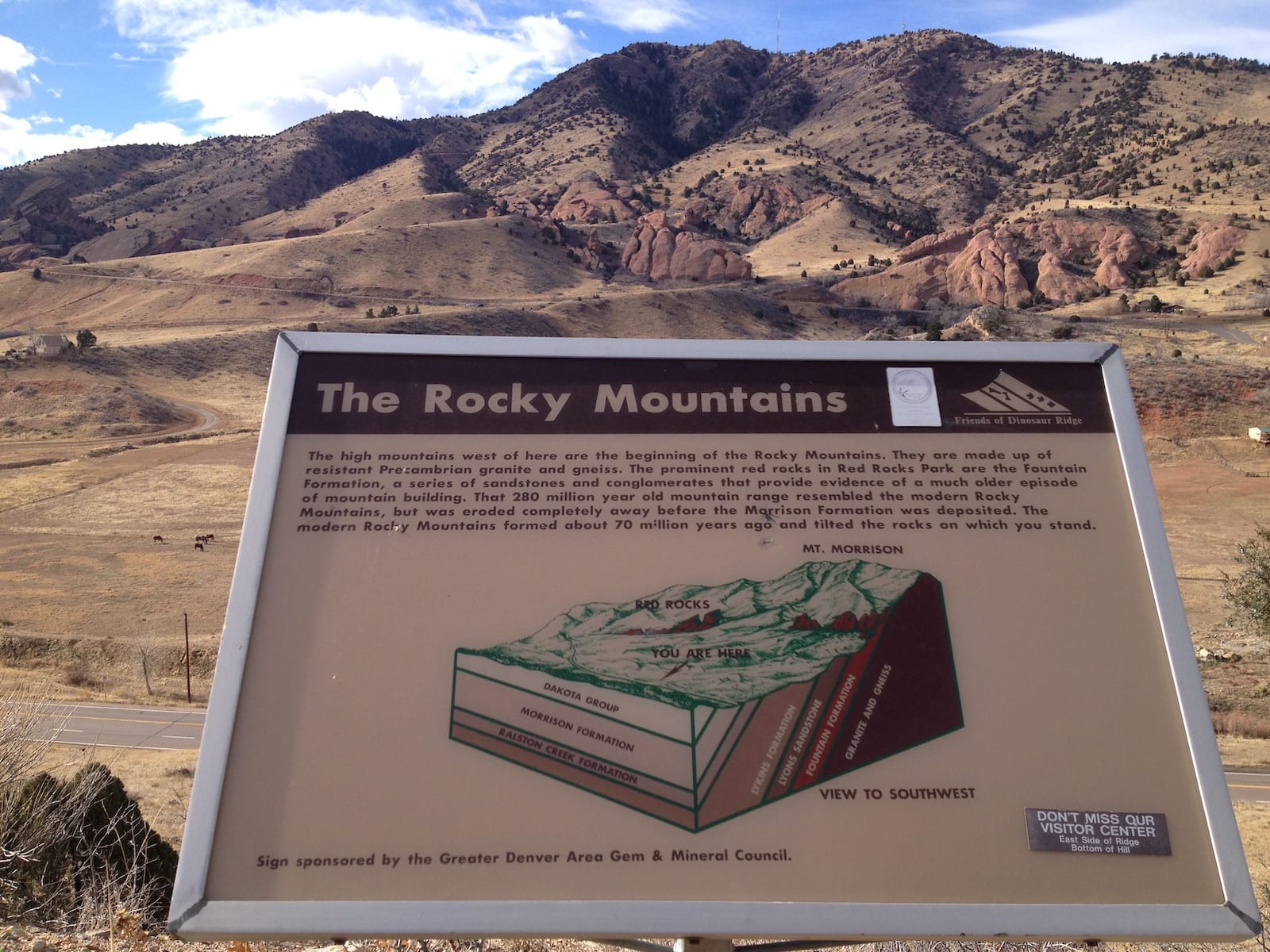 Dinosaur Ridge in Morrison. Photo: Greg Younger
Dinosaur Ridge in Morrison. Photo: Greg Younger
Some include the banana-sized teeth of a Tyrannosaurus rex (found in a basement excavation in Littleton, of all places), enormous bones of T. rex, Triceratops, armored ankylosaurs, duck-billed Edmontosaurus, and dome-headed Pachycephalosaurus, as well as turtles, crocodiles, frogs, lizards, snakes, and small mammals.
These animals lived in scrubby, open forest with palms, ginger plants, and relatives of the avocado tree.
Denver Formation
The Denver Formation spans the boundary between the Age of Dinosaurs and the Age of Mammals (Cenozoic Era), when more than a quarter of earth’s animal species and in some areas as much as 80 percent of plant species became extinct from an asteroid impact. Birds and mammals survived the extinction and took over the latest chapter of Colorado’s prehistory.
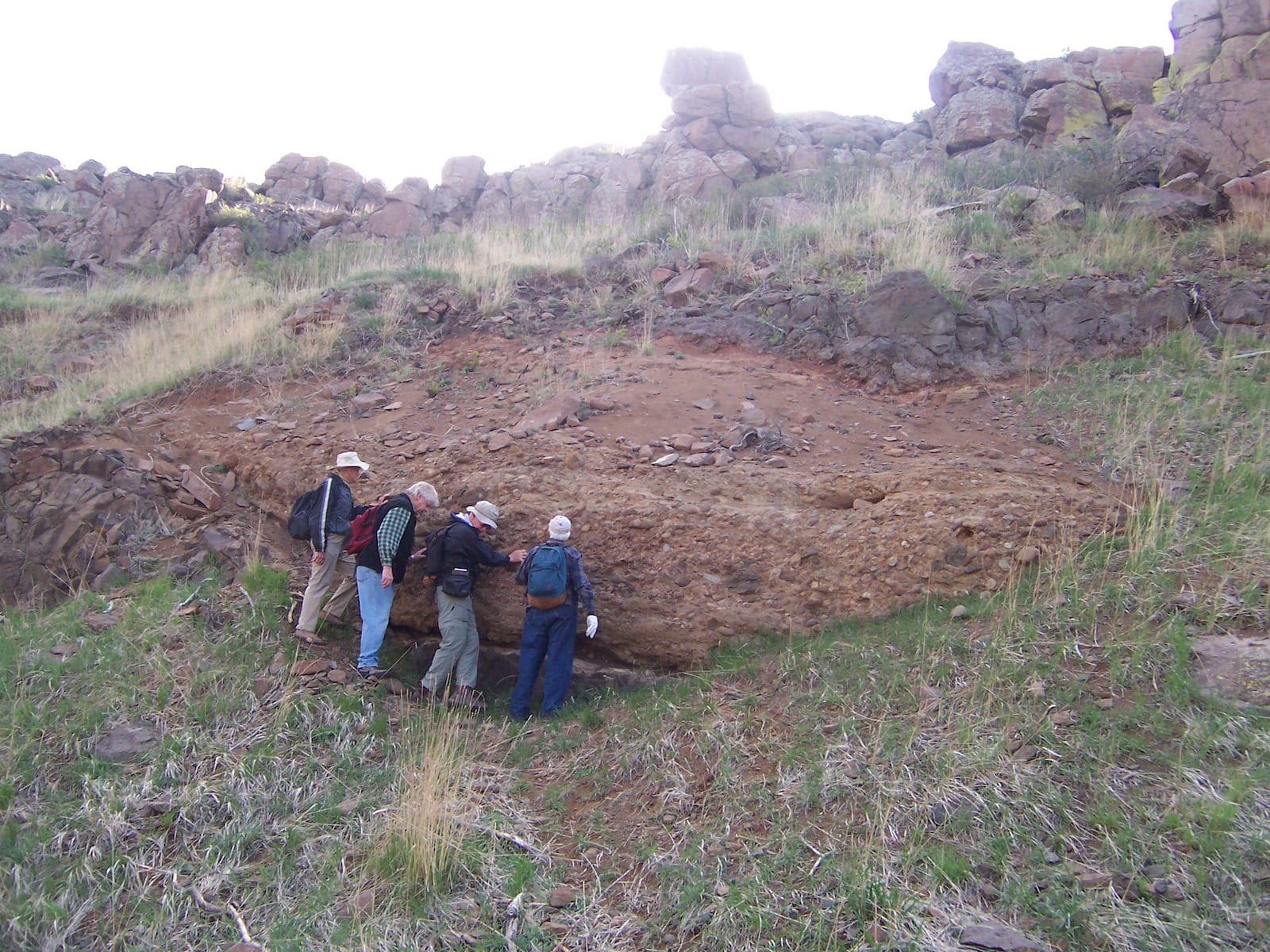 Geologists study an ancient stream bed deposit in the Denver Formation, North Table Mountain, Golden. Photo: Joshuahicks
Geologists study an ancient stream bed deposit in the Denver Formation, North Table Mountain, Golden. Photo: Joshuahicks
Cenozoic: the Age of Mammals
66 to 2.8 million years ago
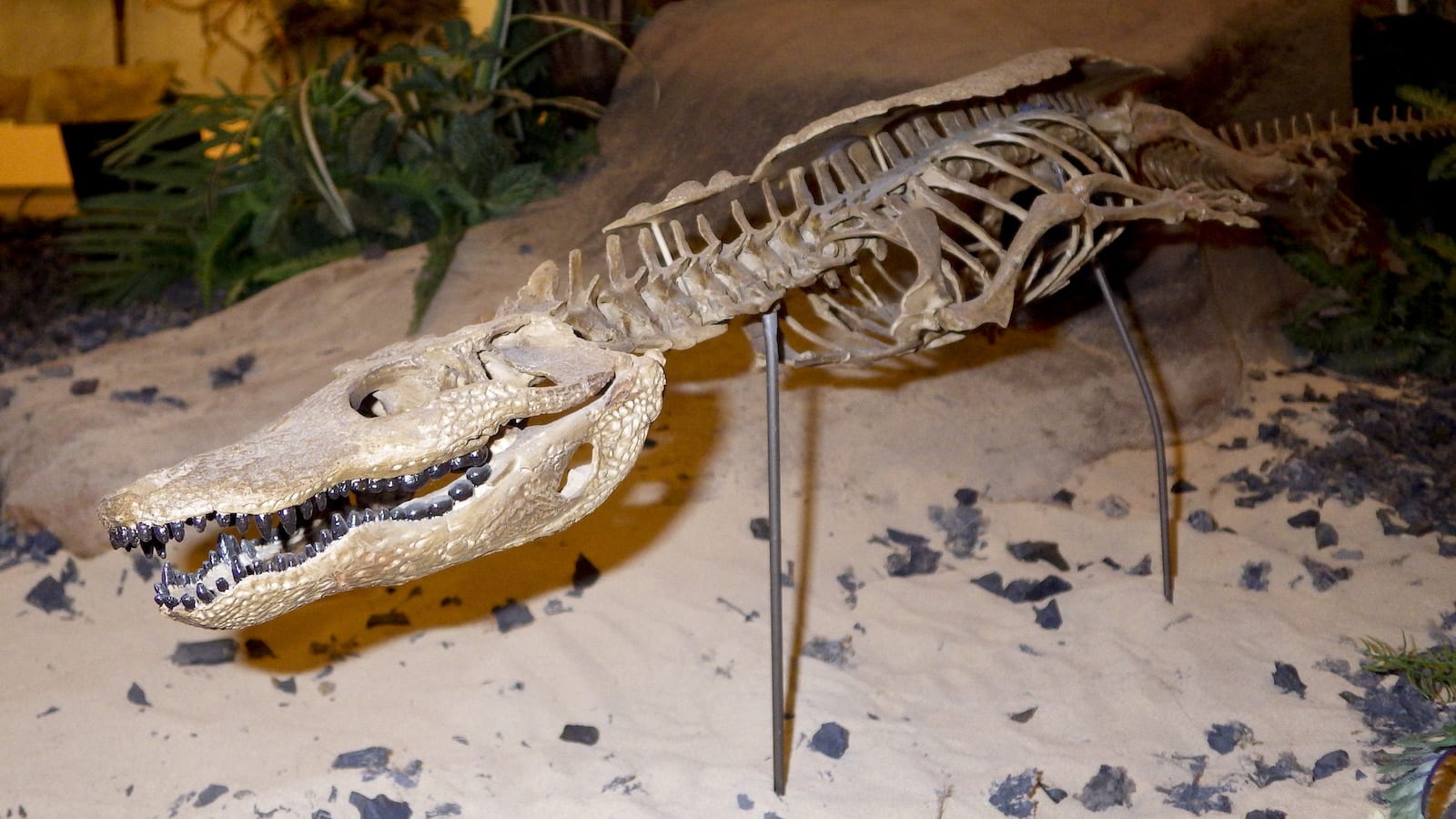 Prehistoric crocodile skeleton at Dinosaur Resource Center, Woodland Park. Photo: Dave Thomas
Prehistoric crocodile skeleton at Dinosaur Resource Center, Woodland Park. Photo: Dave Thomas
The fossils from the Denver Formation are much less diverse after the extinction. Crocodiles and turtles are the largest animals, along with a few small mammals. There are some plants, mostly relatives of palms, sycamores, and walnuts. But this wasn’t the case for long.
Both plants and mammals began to diversify quickly after the extinction, and the fossils in the Denver Formation tell us that, by 64 million years ago, the Front Range was a tropical rainforest, with enormous trees and dangling vines.
At the Castle Rock Rainforest site, paleontologists have excavated a huge amount of fossil plant material, including tree roots and enormous intact leaves. One odd animal discovered in this formation is a mammal known as a taeniodont (teeny-o-dont), a medium-sized lumbering creature that looked a little like a wombat, with long digging claws and teeth designed for gnawing.
The rocks near Paint Mines Interpretive Park, Castle Rock, and Castlewood Canyon State Park were deposited 55 million years ago in a subtropical rainforest along the banks of a slow meandering river. Giant petrified trees as much as 100 feet tall and four feet in diameter are very common (“Parker wood” is the name for this caramel-colored petrified wood found near the town of Parker). Paleontologists also found a tooth of a hippo-like animal called Coryphodon near Parker.
Piceance Basin
At the same time in northwest Colorado, a massive lake had filled the Piceance Basin and deposited the Green River Formation. Millions of fossil fish, as well as crocodiles, turtles, birds, mammals, and insects have been found in this formation, which is also known from Utah and Wyoming. Sycamores, palms, and cattails suggest a warm and humid climate.
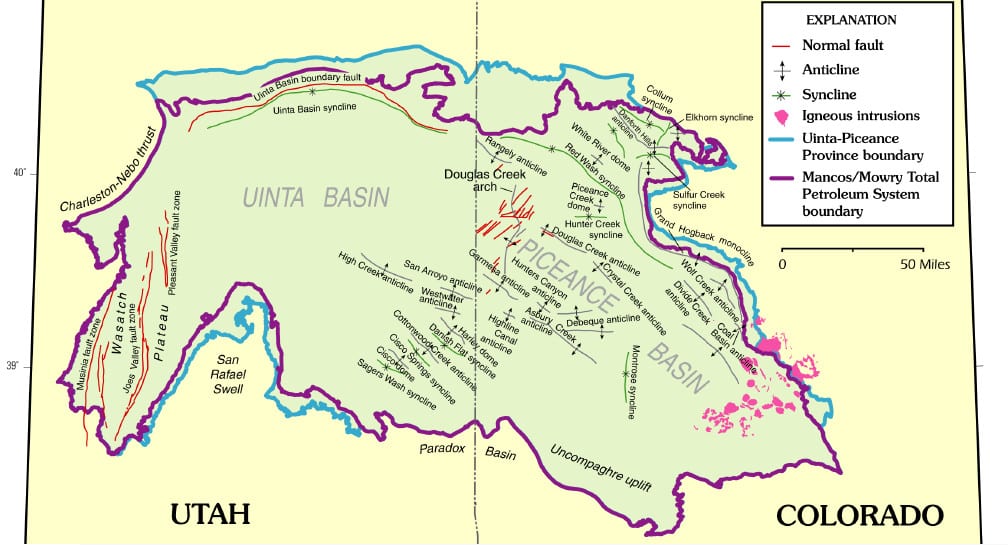 Uinta and Piceance Basins geologic map.
Uinta and Piceance Basins geologic map.
After the dinosaurs disappeared, mammals took off on a wild evolutionary ride and developed all kinds of bizarre shapes and sizes. Near Elbert, the front half of the skeleton of an enormous animal known as a titanothere was found in 34 million-year-old ancient flood deposits. Titanotheres were related to horses and rhinos and had wildly creative bony headgear on their skulls. They browsed in the forests and may have traveled in herds across the Colorado landscape.
Florissant Fossil Beds
Florissant Fossil Beds National Monument is the best place in Colorado (and one of the best places in the West) to learn about life during this same time. Ancient Lake Florissant was home to huge redwoods whose petrified stumps sometimes measure as much as 14 feet in diameter, as well as other plants that include hickories and rubber trees. More than 150 plant species have been discovered there; Florissant’s warm, subtropical forests were such an odd mixture of plants that there is no modern comparison anywhere in the world. Hundreds of insect species are also known from the site, most preserved in beautiful detail.
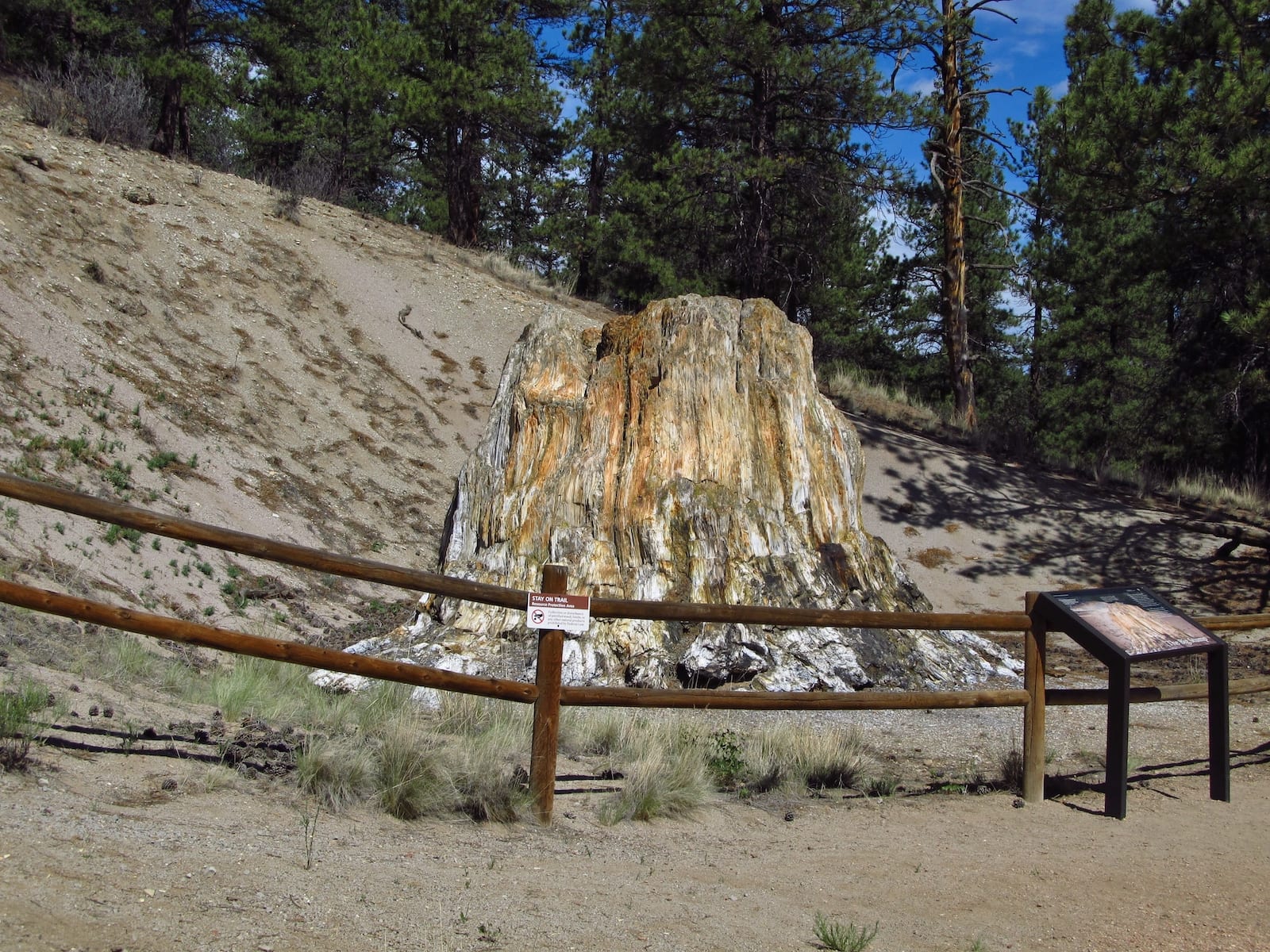 Florissant Fossil Beds National Monument in Divide, Colo. Photo: Jasperdo
Florissant Fossil Beds National Monument in Divide, Colo. Photo: Jasperdo
Uplift and volcanic eruptions in the last 30 million years caused erosion to strip away most of Colorado’s younger rocks where fossils might be found, but there are a few notable exceptions. About 27 million years ago, a volcanic eruption near Creede created a caldera that filled with water and formed a seasonal lake. Several dozen species of plants were described here; it’s the only fossil plant locality from this time period in the southern Rocky Mountains.
And between 15 and 3 million years ago, creatures related to the modern rhinoceros lived in eastern Colorado and elsewhere in the Great Plains.
The Ice Age
2.8 million to 10,000 years ago
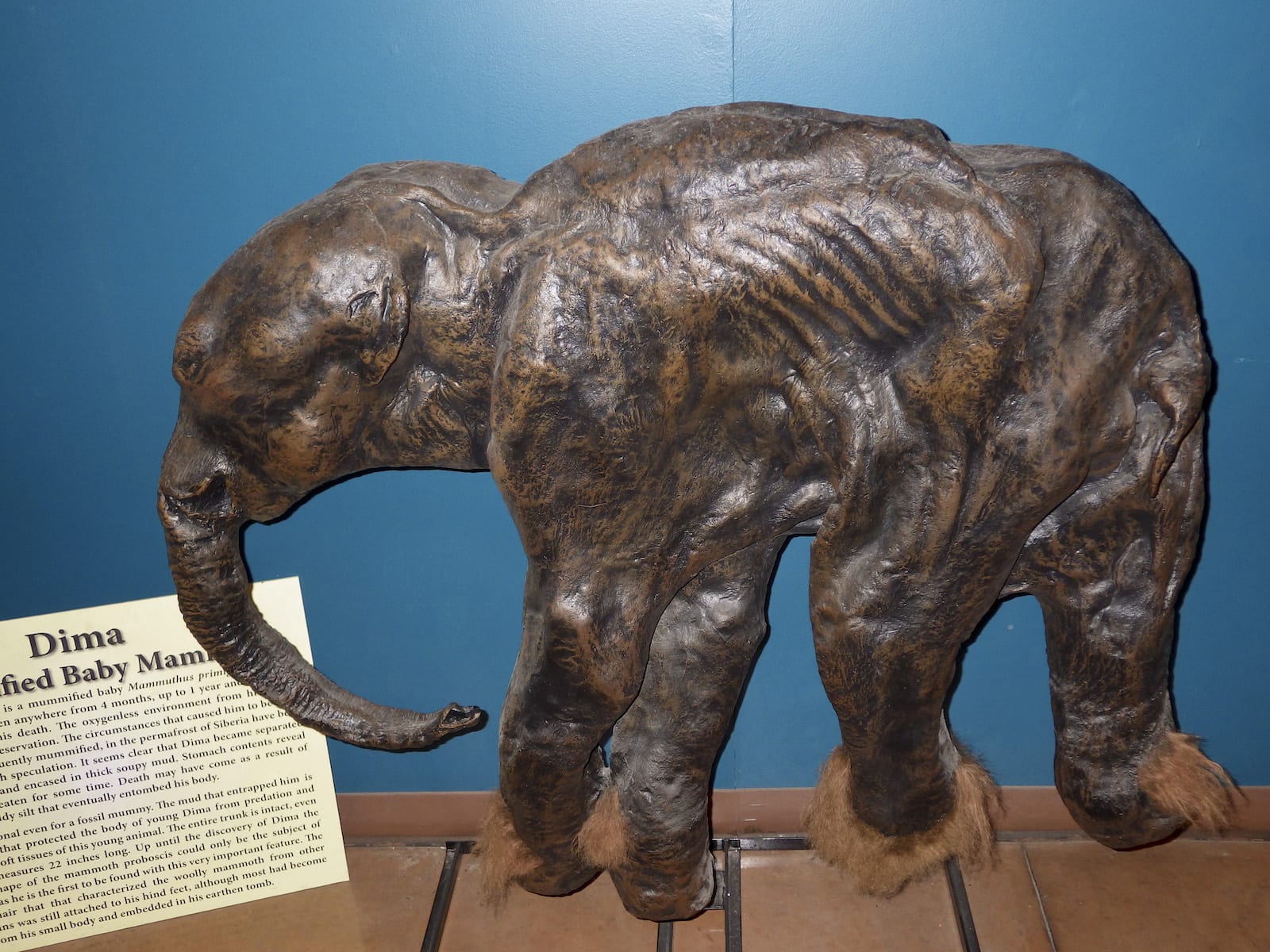 Mummified baby mammoth at Dinosaur Resource Center, Woodland Park. Photo: Dave Thomas
Mummified baby mammoth at Dinosaur Resource Center, Woodland Park. Photo: Dave Thomas
During the Ice Age (Pleistocene Epoch), there were glaciers in the Rocky Mountains but no big ice sheets in Colorado. The summers were cooler and wetter and the winters colder and drier than today.
16,000 years ago, mammoth and mastodon, camels, horses, cheetahs, lions, and giant ground sloths roamed the grasslands and pine forests of the area that would become Highlands Ranch Open Space.
In an ancient lakebed in Snowmass Village, scientists discovered 26 mastodon tusks from at least 13 different individuals. In western Colorado, paleontologists have found Ice Age remains of mammoth, mastodon, and bison in caves, overhangs, and packrat nests. Some of these animals were there when humans arrived in Colorado at the very end of the Ice Age and began to place their mark on the land, forming the latest chapter in the history of life in the state.
Discover Colorado’s Prehistory Interactively
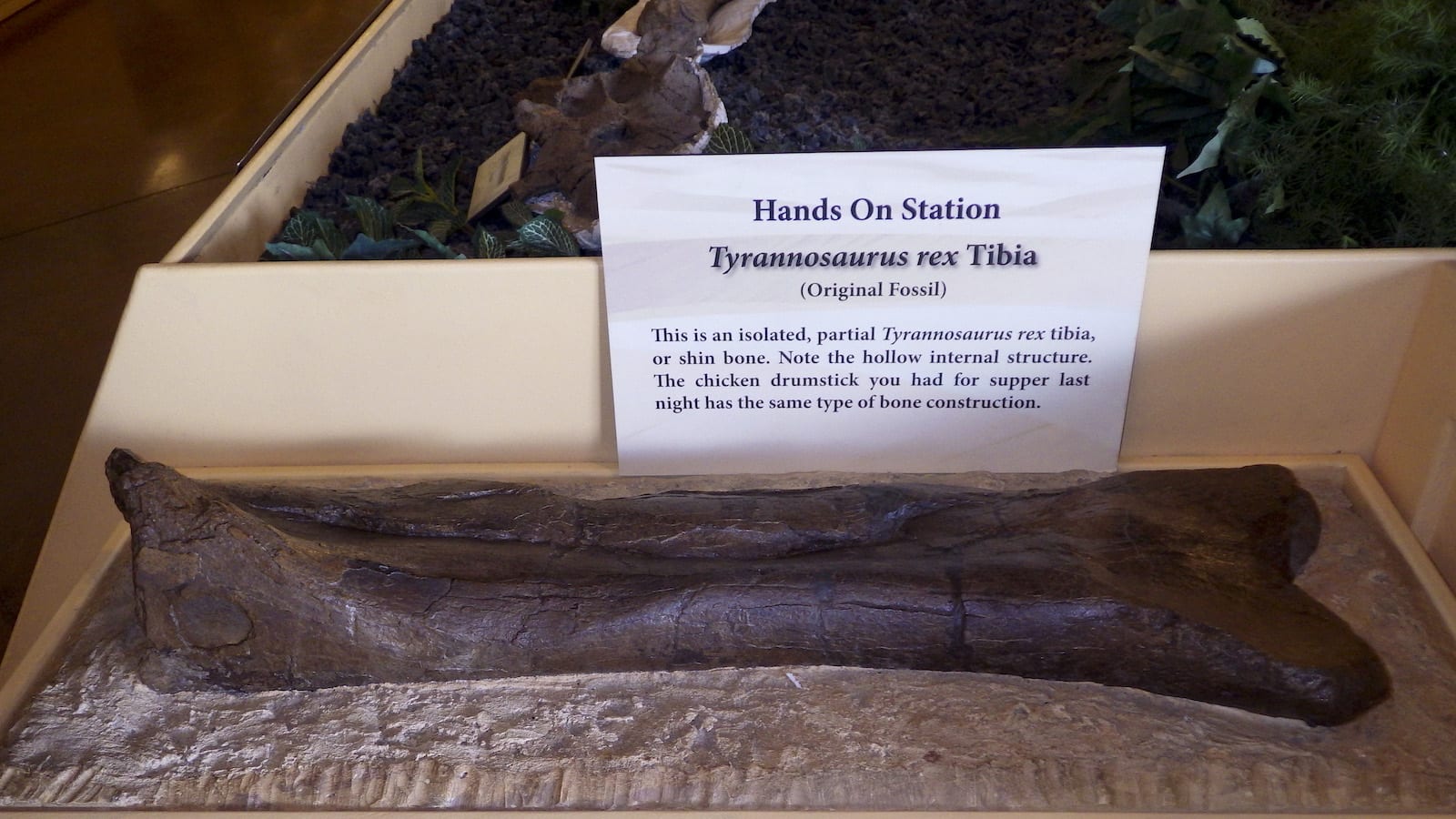 T-Rex interactive fossil exhibit at Dinosaur Resource Center, Woodland Park. Photo: Dave Thomas
T-Rex interactive fossil exhibit at Dinosaur Resource Center, Woodland Park. Photo: Dave Thomas
Thankfully for today’s humans, much of this history has been preserved in a wealth of museums, parks, and fossil quarries. The Denver Museum of Nature and Science is a world-class institution with an amazing exhibit on ancient life and groundbreaking research in paleontology (and other disciplines).
Other sites to learn about fossils found in Colorado include the:
Dinosaur Diamond Byway
Some of these institutions offer opportunities for the public to help on fossil digs or volunteer in the lab, as well as join expert-guided tours of fossil quarries. If you have the time, drive the Dinosaur Diamond Scenic Byway, a 512-mile long route that takes you through the dinosaur discoveries of western Colorado and eastern Utah.
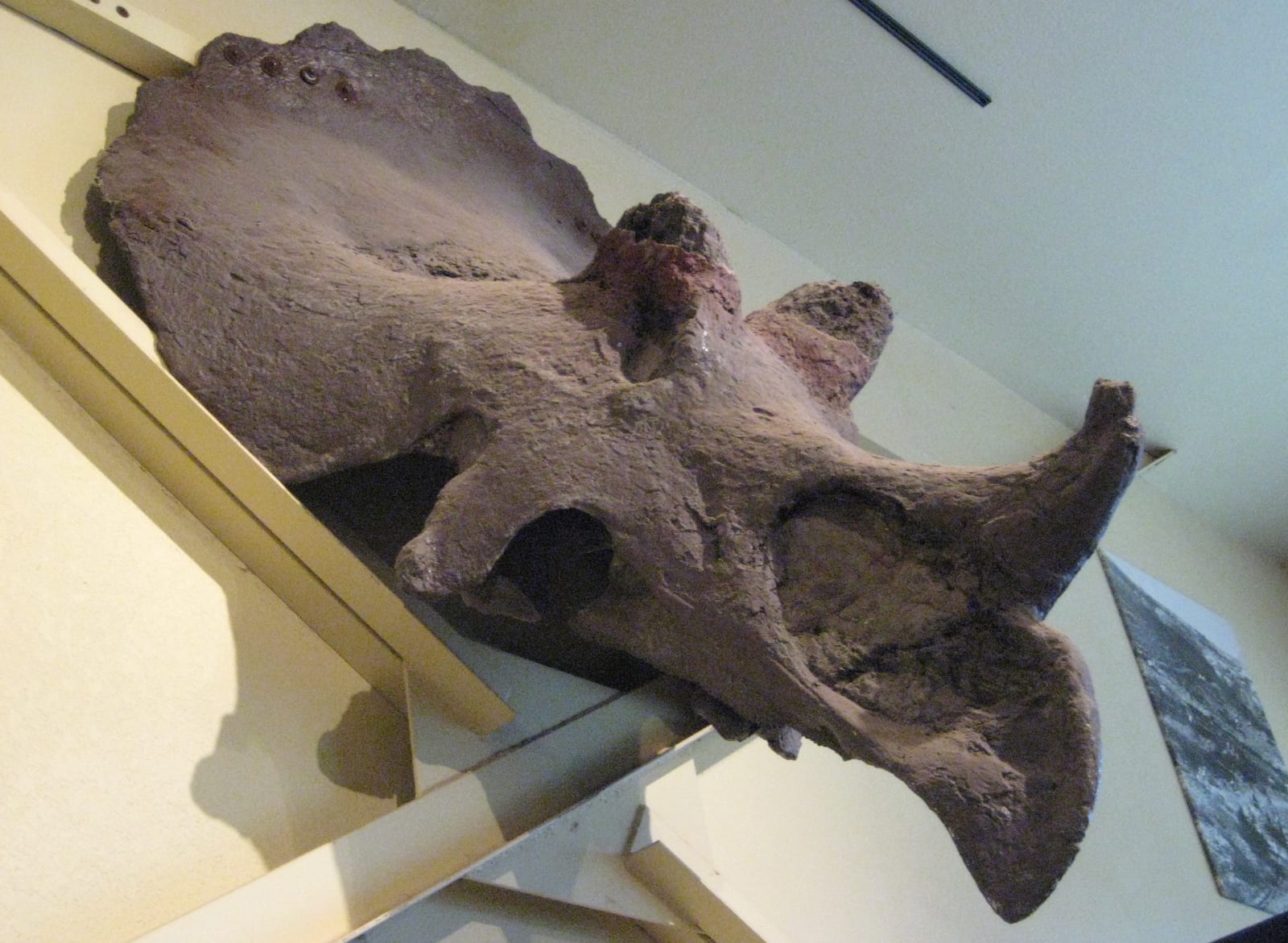 Triceratops skull at Dinosaur Journey Museum in Fruita. Photo: Ellen
Triceratops skull at Dinosaur Journey Museum in Fruita. Photo: Ellen
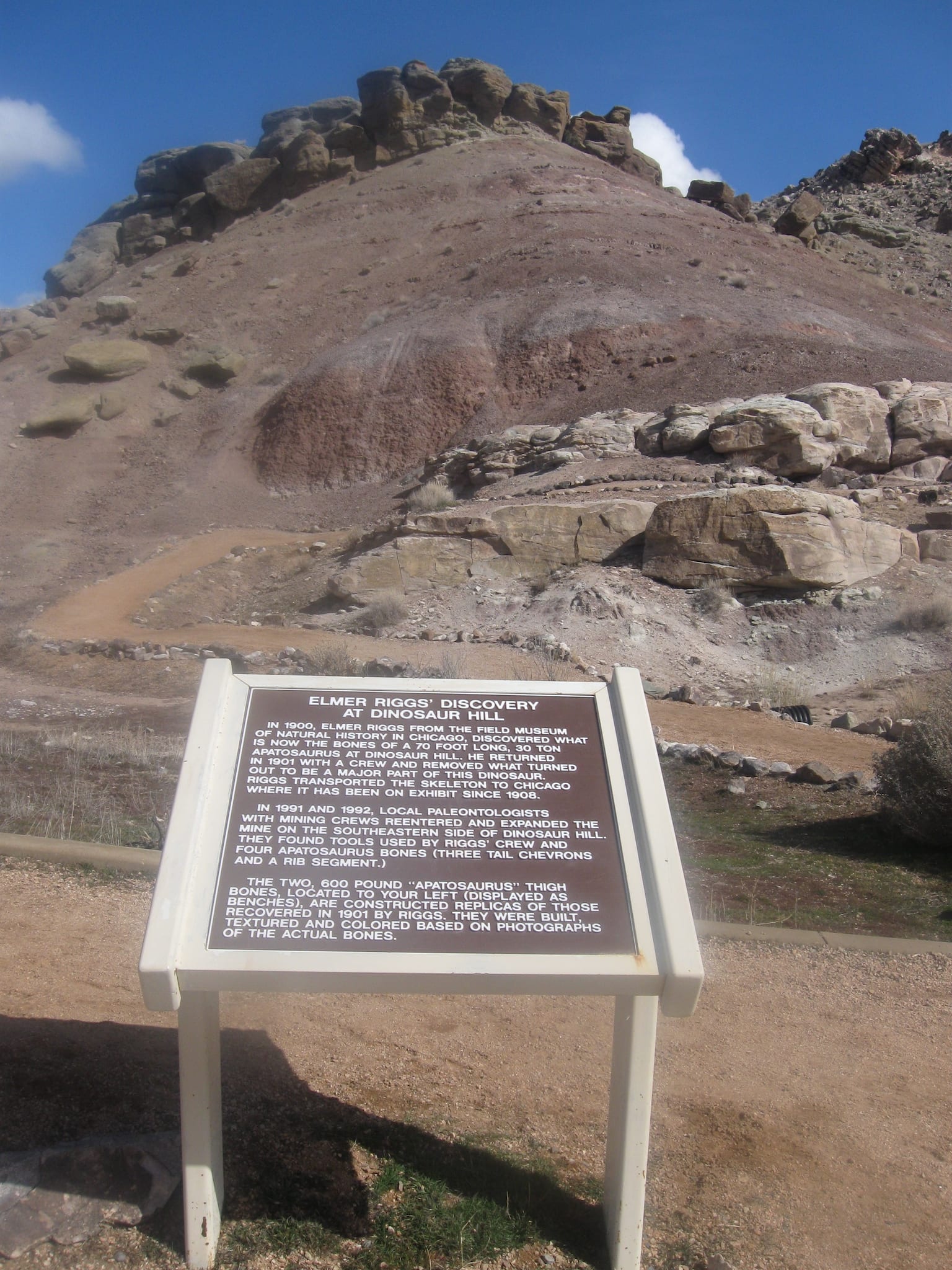 Dinosaur Hill where Elmer Riggs discovered Apatosaurus bones in 1901, Fruita. Photo: Librarianhat
Dinosaur Hill where Elmer Riggs discovered Apatosaurus bones in 1901, Fruita. Photo: Librarianhat
No matter what your fossil interests are, Colorado has more than enough to keep you fascinated and enlightened about the web of life and the long history of our home.
